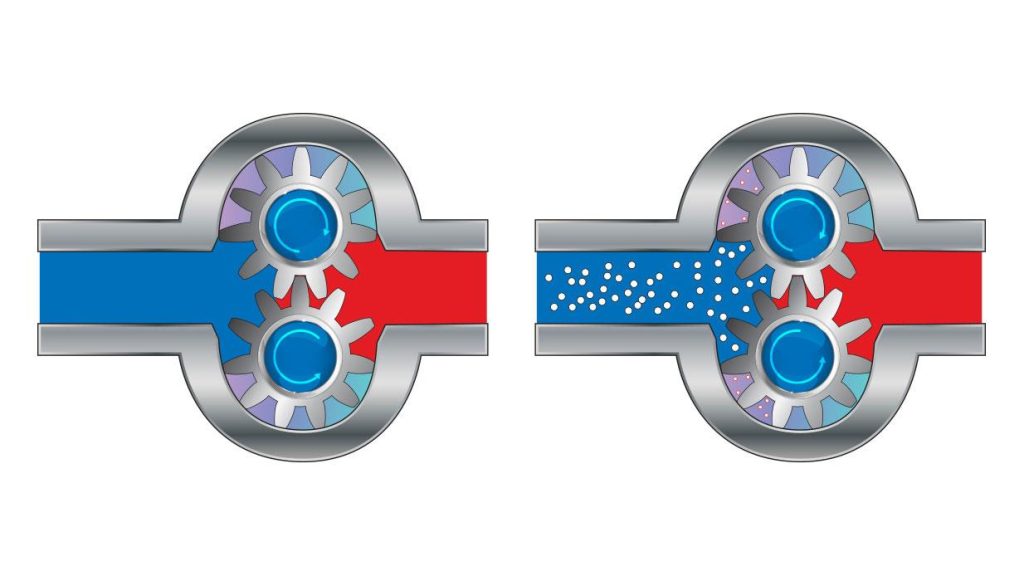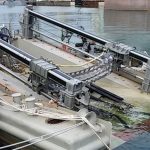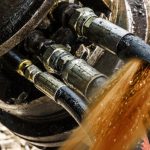Cavitation was first discovered in 1917 when Lord Rayleigh (a British physicist) decided to investigate why fast-rotating ship propellers were eroding at such an incredibly rapid pace. He discovered that it was all down to a condition that came to be known as cavitation.
Cavitation is related to the word, cavity and has the Latin verb ‘cavitere’ at its root. It means to ‘hollow out’ and that’s exactly what cavitation does. Cavitation occurs when very hot small air and gas bubbles develop. As they reach high pressure areas they collapse and cause hot jets to hit the surface of any pipe or components that is reachable causing erosion.
How Cavitation Occurs
When liquid passes through an hydraulic valve, it is under pressure due to the size of the valve. The speed of the flow will rise and then the speed drops again. This change in pressure will create a vapour and then small bubbles of gas will form. When the pressure gets higher than that of the vapour, the bubbles will collapse as the vapour liquefies again. The bubble collapse can send out the heated fluid jets which are very powerful and it’s this that causes so much damage to metal.
Cavitation Damage is Severe
Cavitation is no joke. It can be so severe that it can completely destroy hydraulic valves, pumps and piping to such a degree that the entire system can fail. In between, you may need to contend with leaking valves or even holes in pressure vessel walls.
Even cavitation that is at a low level can wreak havoc by eroding components until they need to be replaced. This is how engineers can recognise that their system is suffering from the effects of cavitation:
· Banging or knocking noise
· Vibrations
· Chocked flow
· Fluid property changes
· Valve component erosion
· Control valve destruction
· Failure of plant leading to shutdown
Cavitation damage can often be identified visually with the use of either a microscope or a magnifying glass. If you are wary that cavitation is causing damage to your hydraulic system, check whether or not it is general wear and tear through corrosion. Some types of corrosion will actually mimic what you’d experience through cavitation. You can expect to find cavitation damage, if it’s in existence, downstream of the seating areas for the control valve. You could very occasionally witness cavitation bubbles further downstream from there.
Another easier way to identify whether your system is suffering from cavitation damage is to listen out for the noise of either crackling or popping. As pressure drop occurs, the cavitation will ramp up and you’ll hear rattling or hissing that increases in volume. If the cavitation is in full operation, it will sound more like you have a lot of small rocks or gravel passing through your system.
Eliminating Cavitation
Cavitation is so powerful that there is currently no known material that can stay undamaged by it. The only way to deal with it is to eliminate it.
One of the simplest ways to eliminate cavitation is to reduce the operating temperature within the hydraulic system. The vapour pressure will be eliminated. If you have identified a valve that is experiencing cavitation, when you replace it, try to install it at the lowest possible elevation within your pipe system.
Another possible solution to cavitation issues is to introduce air or nitrogen into the area of the system where you are expecting to get it. It will need to be added through either the valve shaft or through a tap downstream on aside of the pipe as close as possible to the valve.
If for some reason you are unable to change the process conditions, then it’s recommended that you use valves with low recovery and treacherous flow path as opposed to high recovery valves such as the gate, ball or butterfly types.



Comments are closed